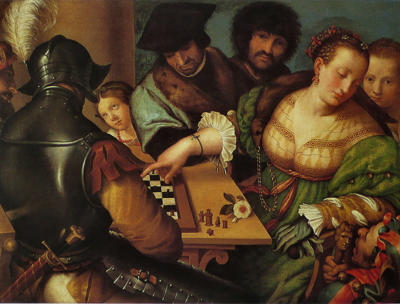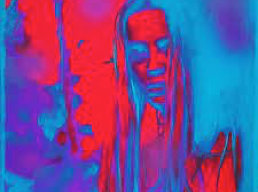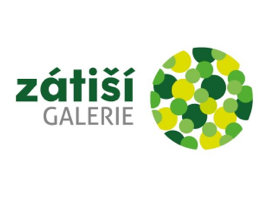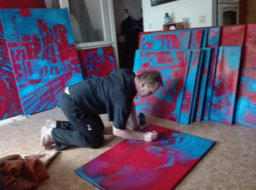Home >
Peter Herel Raabenstein
*17.1.1967
Czech painter and conceptual artist currently living in Prague.
His desire to travel brought him also to the Netherlands where he went in 1996 to study Dutch at the Vrije Universiteit Amsterdam. Peter continued to learn about cultures all over the world, which have been a source of endless inspiration for him. He attended the Gerrit Rietveld Academie painting school. He completed special training in classic painting and colour studies with Professor Rudi Koegler. He is the founder of The Zátiší Gallery in Prague which focuses on contemporary and modern art and the inventor of the special painting technique known as the Red-Blue Dimension.
Why I created the book Chess in Art
My uncle and I shared the same passion for chess, art and history. I wanted something original for his special birthday. A book the content of which would combine all these interests. I searched literally everywhere but there was no such book on the market.
To be able to give my uncle a present, I decided to create at least a calendar with this theme for him. Twelve months of the year, twelve images of chess from history of art. I started looking for and collecting images, sorting and selecting, arranging them and finding out more information about the artists. I became enthusiastic about this unusual project and continued with it, searching for more and more sources. I never finished the calendar but 15 years later, my uncle received the book.

Karel Kobližka, Czech jazzman and Peter’s uncle for whom the book was originally created
How I searched for and selected images for my book
To get the very first images, I went to the central library in Haarlem where I took photographs of five paintings I found in art books. To search for paintings dealing with the subject matter of chess I visited galleries, libraries and museums all over Europe. However, I spent most of my time at the Chess Museum in Amsterdam which became my most important source of materials, knowledge and inspiration. All the staff at the museum share a passion for chess and its history and are more than willing to guide other interested people through the history of this noble game. I have spent a large part of my life in Amsterdam. In addition to the museum, there is a library in the city with a large collection of chess books.
So, this is how I have collected more than 1,300 images. At that moment I thought to myself that this is material worthy of a whole book. For the next few years I was trying to find out whether the selected images of the paintings could be found in higher quality somewhere and I also looked for their originals. Unfortunately, I could not find many of the images in required quality or could not trace them, so only a portion of the collection made it into the book.



What playing chess means to me
My grandfather taught me the rules of chess when I was five years old. Although I have never played in a chess club or at the professional level, I always travel with a chess set and always hold it in my hands. I think that through chess people can beautifully connect with each other without words and overcome language barriers. And that’s what I appreciate most about it when I travel the world.
My hobby has taken me to many tournaments as well as to professional chess players. I have always enjoyed returning to Wijk aan Zee for world-class tournaments. It was there that I had the opportunity to meet the best chess players.
Chess is the love of a lifetime
What surprised and intrigued me during my research
There is always something in the history of chess that surprises me. Whether it’s the shape of pieces changing over time and place or, by contrast, the fact that the rules of the game have not changed at all since its recorded beginnings. Last but not least, the colours and materials used to make chessboards and pieces, which reflected local availability and aesthetic values.
What I found most interesting, however, was the culture that arose in connection with the game of chess. As early as the fourteenth century, for instance, women were playing chess – that is from the very beginnings of the modern game. And, also, the fact that in the Arab countries, where the origins of the game date back to, chess had a significant cultural value.
What significant changes in depiction of the chess game can be found in the book
The surviving artworks indicate that playing chess was, for a long time, the pastime of the nobility and the rich. The lower classes had neither the time nor the opportunity to learn how to play the game. The depiction of chess in art has transformed as the lifestyle of human society has changed. It could be said that almost all artists depicting chess also played it and drew inspiration for their works from the game.
One essential thing, however, has not changed – the rules of the game.
If I had to pick one painting that I consider the most important
To me, the most valuable painting in the collection is The Chess Game by the Italian painter Sofonisba Anguissola, depicting three of her sisters playing chess and their maid watching the game. Anguissola created the painting at the age of twenty-three in 1555, as inscribed on the edge of the chessboard along with the inscription, “SOPHONISBA ANGUSSOLA VIRGO AMILCARIS FILIA EX VERA EFFIGIE TRES SUAS SORORES ET ANCILLAM PINXIT MDLV” (“Sofonisba Angussola, the virgin daughter of Amilcare, painted these three sisters and the maid from life”).
I received a postcard with this painting from a good Polish friend and it became the very first image in my collection. The original painting can be seen in the National Museum in Poznan, Poland.

The Game of Chess, Sofonisba Anguissola
More content in my book.
“Chess in Art”
Red-Blue Dimension
Completely new and unique interactive artistic technique using optical illusions invention by Peter Herel Raabenstein.
Read more
The Zátiší Gallery
A gallery focused on modern and contemporary art founded by Peter Herel Raabenstein.
Read more
Workshops
Special art workshops organised by Peter Herel Raabenstein for the public.
Read more
Works
Peter Herel Raabenstein’s paintings, art and other works are published on his personal blog.
Read more




